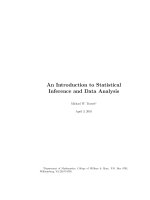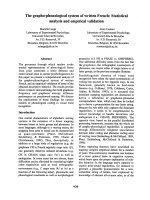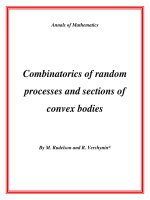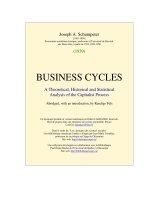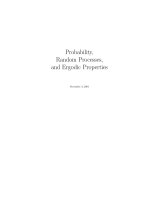Probability, random processes, and statistical analysis
Bạn đang xem bản rút gọn của tài liệu. Xem và tải ngay bản đầy đủ của tài liệu tại đây (4.37 MB, 813 trang )
Probability, Random Processes, and Statistical Analysis
Together with the fundamentals of probability, random processes, and statistical analysis, this insightful book also presents a broad range of advanced topics and applications
not covered in other textbooks.
Advanced topics include:
•
•
•
•
•
•
•
•
•
•
•
•
Bayesian inference and conjugate priors
Chernoff bound and large deviation approximation
Principal component analysis and singular value decomposition
Autoregressive moving average (ARMA) time series
Maximum likelihood estimation and the Expectation-Maximization (EM) algorithm
Brownian motion, geometric Brownian motion, and Ito process
Black–Scholes differential equation for option pricing
Hidden Markov model (HMM) and estimation algorithms
Bayesian networks and sum-product algorithm
Markov chain Monte Carlo methods
Wiener and Kalman filters
Queueing and loss networks
The book will be useful to students and researchers in such areas as communications,
signal processing, networks, machine learning, bioinformatics, and econometrics and
mathematical finance. With a solutions manual, lecture slides, supplementary materials,
and MATLAB programs all available online, it is ideal for classroom teaching as well
as a valuable reference for professionals.
Hisashi Kobayashi is the Sherman Fairchild University Professor Emeritus at Princeton
University, where he was previously Dean of the School of Engineering and Applied
Science. He also spent 15 years at the IBM Research Center, Yorktown Heights, NY,
and was the Founding Director of IBM Tokyo Research Laboratory. He is an IEEE Life
Fellow, an IEICE Fellow, was elected to the Engineering Academy of Japan (1992), and
received the 2005 Eduard Rhein Technology Award.
Brian L. Mark is a Professor in the Department of Electrical and Computer Engineering at George Mason University. Prior to this, he was a research staff member at the
NEC C&C Research Laboratories in Princeton, New Jersey, and in 2002 he received a
National Science Foundation CAREER award.
William Turin is currently a Consultant at AT&T Labs Research. As a Member of Technical Staff at AT&T Bell Laboratories and later a Technology Consultant at AT&T
Labs Research for 21 years, he developed methods for quantifying the performance
of communication systems. He is the author of six books and numerous papers.
www.pdfgrip.com
“This book provides a very comprehensive, well-written and modern approach to the
fundamentals of probability and random processes, together with their applications in
the statistical analysis of data and signals. It provides a one-stop, unified treatment that
gives the reader an understanding of the models, methodologies, and underlying principles behind many of the most important statistical problems arising in engineering and
the sciences today.”
Dean H. Vincent Poor, Princeton University
“This is a well-written, up-to-date graduate text on probabilty and random processes. It
is unique in combining statistical analysis with the probabilistic material. As noted by
the authors, the material, as presented, can be used in a variety of current application
areas, ranging from communications to bioinformatics. I particularly liked the historical
introduction, which should make the field exciting to the student, as well as the introductory chapter on probability, which clearly describes for the student the distinction
between the relative frequency and axiomatic approaches to probability. I recommend
it unhesitatingly. It deserves to become a leading text in the field.”
Professor Emeritus Mischa Schwartz, Columbia University
“Hisashi Kobayashi, Brian L. Mark, and William Turin are highly experienced university teachers and scientists. Based on this background, their book covers not only
fundamentals, but also a large range of applications. Some of them are treated in a
textbook for the first time. Without any doubt the book will be extremely valuable to
graduate students and to scientists in universities and industry. Congratulations to the
authors!”
Professor Dr.-Ing. Eberhard Hänsler, Technische Universität Darmstadt
“An up-to-date and comprehensive book with all the fundamentals in probability, random processes, stochastic analysis, and their interplays and applications, which lays a
solid foundation for the students in related areas. It is also an ideal textbook with five
relatively independent but logically interconnected parts and the corresponding solution
manuals and lecture slides. Furthermore, to my best knowledge, similar editing in Part
IV and Part V can’t be found elsewhere.”
Zhisheng Niu, Tsinghua University
www.pdfgrip.com
Probability, Random Processes,
and Statistical Analysis
HISASHI KO BAYASHI
Princeton University
BRIAN L. MARK
George Mason University
WILLIAM TURIN
AT&T Labs Research
www.pdfgrip.com
CAMBRIDGE UNIVERSITY PRESS
Cambridge, New York, Melbourne, Madrid, Cape Town
Singapore, São Paulo, Delhi, Tokyo, Mexico City
Cambridge University Press
The Edinburgh Building, Cambridge CB2 8RU, UK
Published in the United States of America by Cambridge University Press, New York
www.cambridge.org
Information on this title: www.cambridge.org/9780521895446
c Cambridge University Press 2012
This publication is in copyright. Subject to statutory exception
and to the provisions of relevant collective licensing agreements,
no reproduction of any part may take place without the written
permission of Cambridge University Press.
First published 2012
Printed in the United Kingdom at the University Press, Cambridge
A catalogue record for this publication is available from the British Library
ISBN 978-0-521-89544-6 Hardback
Additional resources for this publication at www.cambridge.org/9780521895446
Cambridge University Press has no responsibility for the persistence or
accuracy of URLs for external or third-party internet websites referred to
in this publication, and does not guarantee that any content on such
websites is, or will remain, accurate or appropriate.
www.pdfgrip.com
To
Masae, Karen, and Galina
www.pdfgrip.com
www.pdfgrip.com
Contents
List of abbreviations and acronyms
Preface
Acknowledgments
1
Introduction
1.1
1.2
1.3
page xviii
xxiii
xxx
1
Why study probability, random processes, and statistical analysis?
1.1.1
Communications, information, and control systems
1.1.2
Signal processing
1.1.3
Machine learning
1.1.4
Biostatistics, bioinformatics, and related fields
1.1.5
Econometrics and mathematical finance
1.1.6
Queueing and loss systems
1.1.7
Other application domains
History and overview
1.2.1
Classical probability theory
1.2.2
Modern probability theory
1.2.3
Random processes
1.2.4
Statistical analysis and inference
Discussion and further reading
1
2
2
3
4
4
6
6
7
7
9
10
12
14
Part I Probability, random variables, and statistics
15
2
Probability
17
2.1
17
17
18
18
19
19
20
21
2.2
Randomness in the real world
2.1.1
Repeated experiments and statistical regularity
2.1.2
Random experiments and relative frequencies
Axioms of probability
2.2.1
Sample space
2.2.2
Event
2.2.3
Probability measure
2.2.4
Properties of probability measure
www.pdfgrip.com
viii
Contents
2.3
2.4
2.5
2.6
2.7
3
26
30
30
31
34
36
37
37
Discrete random variables
42
3.1
42
43
44
45
46
50
51
53
54
55
56
59
62
65
66
66
3.2
3.3
3.4
3.5
3.6
4
Bernoulli trials and Bernoulli’s theorem
Conditional probability, Bayes’ theorem, and statistical independence
2.4.1
Joint probability and conditional probability
2.4.2
Bayes’ theorem
2.4.3
Statistical independence of events
Summary of Chapter 2
Discussion and further reading
Problems
Random variables
3.1.1
Distribution function
3.1.2
Two random variables and joint distribution function
Discrete random variables and probability distributions
3.2.1
Joint and conditional probability distributions
3.2.2
Moments, central moments, and variance
3.2.3
Covariance and correlation coefficient
Important probability distributions
3.3.1
Bernoulli distribution and binomial distribution
3.3.2
Geometric distribution
3.3.3
Poisson distribution
3.3.4
Negative binomial (or Pascal) distribution
3.3.5
Zipf’s law and zeta distribution
Summary of Chapter 3
Discussion and further reading
Problems
Continuous random variables
72
4.1
72
72
73
75
75
76
78
80
86
88
90
92
94
95
97
4.2
4.3
4.4
4.5
Continuous random variables
4.1.1
Distribution function and probability density function
4.1.2
Expectation, moments, central moments, and variance
Important continuous random variables and their distributions
4.2.1
Uniform distribution
4.2.2
Exponential distribution
4.2.3
Gamma distribution
4.2.4
Normal (or Gaussian) distribution
4.2.5
Weibull distributions
4.2.6
Pareto distribution
Joint and conditional probability density functions
4.3.1
Bivariate normal (or Gaussian) distribution
4.3.2
Multivariate normal (or Gaussian) distribution
Exponential family of distributions
Bayesian inference and conjugate priors
www.pdfgrip.com
ix
Contents
4.6
4.7
4.8
5
112
5.1
5.2
5.3
5.4
112
115
119
123
124
125
130
131
131
132
Function of one random variable
Function of two random variables
Two functions of two random variables and the Jacobian matrix
Generation of random variates for Monte Carlo simulation
5.4.1
Random number generator (RNG)
5.4.2
Generation of variates from general distributions
5.4.3
Generation of normal (or Gaussian) variates
Summary of Chapter 5
Discussion and further reading
Problems
Fundamentals of statistical data analysis
138
6.1
6.2
6.3
138
140
141
142
144
148
149
152
152
153
6.4
6.5
6.6
7
103
104
104
Functions of random variables and their distributions
5.5
5.6
5.7
6
Summary of Chapter 4
Discussion and further reading
Problems
Sample mean and sample variance
Relative frequency and histograms
Graphical presentations
6.3.1
Histogram on probability paper
6.3.2
Log-survivor function curve
6.3.3
Hazard function and mean residual life curves
6.3.4
Dot diagram and correlation coefficient
Summary of Chapter 6
Discussion and further reading
Problems
Distributions derived from the normal distribution
157
7.1
7.2
7.3
7.4
7.5
157
161
163
165
167
168
170
172
172
173
176
177
178
7.6
7.7
7.8
7.9
Chi-squared distribution
Student’s t-distribution
Fisher’s F-distribution
Log-normal distribution
Rayleigh and Rice distributions
7.5.1
Rayleigh distribution
7.5.2
Rice distribution
Complex-valued normal variables
7.6.1
Complex-valued Gaussian variables and their properties
7.6.2
Multivariate Gaussian variables
Summary of Chapter 7
Discussion and further reading
Problems
www.pdfgrip.com
x
Contents
Part II Transform methods, bounds, and limits
183
8
Moment-generating function and characteristic function
185
8.1
185
185
8.2
8.3
8.4
8.5
9
189
190
192
192
196
198
199
201
202
204
205
206
Generating functions and Laplace transform
211
9.1
211
212
215
217
218
226
226
229
234
235
235
9.2
9.3
9.4
9.5
10
Moment-generating function (MGF)
8.1.1
Moment-generating function of one random variable
8.1.2
Moment-generating function of sum of independent random
variables
8.1.3
Joint moment-generating function of multivariate random
variables
Characteristic function (CF)
8.2.1
Characteristic function of one random variable
8.2.2
Sum of independent random variables and convolution
8.2.3
Moment generation from characteristic function
8.2.4
Joint characteristic function of multivariate random
variables
8.2.5
Application of the characteristic function: the central limit
theorem (CLT)
8.2.6
Characteristic function of multivariate complex-valued
normal variables
Summary of Chapter 8
Discussion and further reading
Problems
Generating function
9.1.1
Probability-generating function (PGF)
9.1.2
Sum of independent variables and convolutions
9.1.3
Sum of a random number of random variables
9.1.4
Inverse transform of generating functions
Laplace transform method
9.2.1
Laplace transform and moment generation
9.2.2
Inverse Laplace transform
Summary of Chapter 9
Discussion and further reading
Problems
Inequalities, bounds, and large deviation approximation
241
10.1
241
241
245
246
248
Inequalities frequently used in probability theory
10.1.1 Cauchy–Schwarz inequality
10.1.2 Jensen’s inequality
10.1.3 Shannon’s lemma and log-sum inequality
10.1.4 Markov’s inequality
www.pdfgrip.com
xi
Contents
10.1.5
10.1.6
Chebyshev’s inequality
Kolmogorov’s inequalities for martingales and
submartingales
Chernoff’s bounds
10.2.1 Chernoff’s bound for a single random variable
10.2.2 Chernoff’s bound for a sum of i.i.d. random variables
Large deviation theory
10.3.1 Large deviation approximation
10.3.2 Large deviation rate function
Summary of Chapter 10
Discussion and further reading
Problems
249
Convergence of a sequence of random variables and the limit theorems
277
11.1
277
277
278
280
280
282
285
288
292
293
294
298
300
303
306
307
308
10.2
10.3
10.4
10.5
10.6
11
11.2
11.3
11.4
11.5
11.6
Preliminaries: convergence of a sequence of numbers or functions
11.1.1 Sequence of numbers
11.1.2 Sequence of functions
Types of convergence for sequences of random variables
11.2.1 Convergence in distribution
11.2.2 Convergence in probability
11.2.3 Almost sure convergence
11.2.4 Convergence in the r th mean
11.2.5 Relations between the modes of convergence
Limit theorems
11.3.1 Infinite sequence of events
11.3.2 Weak law of large numbers (WLLN)
11.3.3 Strong laws of large numbers (SLLN)
11.3.4 The central limit theorem (CLT) revisited
Summary of Chapter 11
Discussion and further reading
Problems
250
253
253
254
257
257
263
267
268
269
Part III Random processes
313
12
Random processes
315
12.1
12.2
315
316
316
317
317
318
318
321
Random process
Classification of random processes
12.2.1 Discrete-time versus continuous-time processes
12.2.2 Discrete-state versus continuous-state processes
12.2.3 Stationary versus nonstationary processes
12.2.4 Independent versus dependent processes
12.2.5 Markov chains and Markov processes
12.2.6 Point processes and renewal processes
www.pdfgrip.com
xii
Contents
12.3
12.4
12.5
12.6
12.7
13
321
322
322
323
326
327
329
329
330
333
338
339
340
340
Spectral representation of random processes and time series
343
13.1
343
343
345
346
348
350
357
357
363
372
372
380
13.2
13.3
13.4
13.5
13.6
13.7
14
12.2.7 Real-valued versus complex-valued processes
12.2.8 One-dimensional versus vector processes
Stationary random process
12.3.1 Strict stationarity versus wide-sense stationarity
12.3.2 Gaussian process
12.3.3 Ergodic processes and ergodic theorems
Complex-valued Gaussian process
12.4.1 Complex-valued Gaussian random variables
12.4.2 Complex-valued Gaussian process
12.4.3 Hilbert transform and analytic signal
12.4.4 Complex envelope
Summary of Chapter 12
Discussion and further reading
Problems
Spectral representation of random processes and time series
13.1.1 Fourier series
13.1.2 Fourier transform
13.1.3 Analysis of periodic wide-sense stationary random process
13.1.4 Power spectrum
13.1.5 Power spectrum and periodogram of time series
Generalized Fourier series expansions
13.2.1 Review of matrix analysis
13.2.2 Karhunen–Loève expansion and its applications
Principal component analysis and singular value decomposition
13.3.1 Principal component analysis (PCA)
13.3.2 Singular value decomposition (SVD)
13.3.3 Matrix decomposition methods for Web information
retrieval
Autoregressive moving average time series and its spectrum
13.4.1 Autoregressive (AR) time series
13.4.2 Moving average (MA) time series
13.4.3 Autoregressive moving average (ARMA) time series
13.4.4 Autoregressive integrated moving average (ARIMA)
time series
Summary of Chapter 13
Discussion and further reading
Problems
384
385
385
389
390
392
393
394
395
Poisson process, birth–death process, and renewal process
400
14.1
400
400
The Poisson process
14.1.1 Derivation of the Poisson process
www.pdfgrip.com
xiii
Contents
14.2
14.3
14.4
14.5
14.6
15
403
407
410
411
413
417
418
419
Discrete-time Markov chains
424
15.1
15.2
424
429
430
433
438
439
440
15.3
15.4
15.5
15.6
16
14.1.2 Properties of the Poisson process
Birth–death (BD) process
Renewal process
14.3.1 Renewal function and renewal equation
14.3.2 Residual life in a renewal process
Summary of Chapter 14
Discussion and further reading
Problems
Markov processes and Markov chains
Computation of state probabilities
15.2.1 Generating function method
15.2.2 Spectral expansion method
Classification of states
15.3.1 Recurrent and transient states
15.3.2 Criteria for state classification
15.3.3 Communicating states and an irreducible Markov
chain
15.3.4 Stationary distribution of an aperiodic irreducible
chain
Summary of Chapter 15
Discussion and further reading
Problems
445
448
450
451
452
Semi-Markov processes and continuous-time Markov chains
455
16.1
16.2
455
459
16.3
16.4
16.5
16.6
16.7
Semi-Markov process
Continuous-time Markov chain (CTMC)
16.2.1 Infinitesimal generator and embedded Markov chain
of a continuous-time Markov chain
16.2.2 Kolmogorov’s forward and backward equations
16.2.3 Spectral expansion of the infinitesimal generator
Reversible Markov chains
16.3.1 Reversible discrete-time Markov chain
16.3.2 Reversible continuous-time Markov chain
An application: phylogenetic tree and its Markov chain
representation
16.4.1 Trees and phylogenetic trees
16.4.2 Markov process on a tree
16.4.3 Continuous-time Markov chain model
Summary of Chapter 16
Discussion and further reading
Problems
www.pdfgrip.com
459
462
464
467
467
469
470
471
473
474
476
477
478
xiv
Contents
17
Random walk, Brownian motion, diffusion, and Itô processes
483
17.1
483
483
486
489
489
491
493
496
496
499
17.2
17.3
17.4
17.5
17.6
17.7
Random walk
17.1.1 Simple random walk
17.1.2 Gambler’s ruin
Brownian motion or Wiener process
17.2.1 Wiener process as a limit process
17.2.2 Properties of the Wiener process
17.2.3 White noise
Diffusion processes and diffusion equations
17.3.1 Fokker–Planck equation for Brownian motion with drift
17.3.2 Einstein’s diffusion equation for Brownian motion
17.3.3 Forward and backward equations for general diffusion
processes
17.3.4 Ornstein–Uhlenbeck process: Gauss–Markov process
Stochastic differential equations and Itô process
17.4.1 Itô’s formula
17.4.2 Geometric Brownian motion (GBM)
17.4.3 The Black–Scholes model: an application of an Itô
process
Summary of Chapter 17
Discussion and further reading
Problems
500
502
506
507
508
511
514
516
516
Part IV Statistical inference
521
18
Estimation and decision theory
523
18.1
523
527
528
532
536
538
539
540
542
18.2
18.3
18.4
Parameter estimation
18.1.1 Exponential family of distributions revisited
18.1.2 Maximum-likelihood estimation
18.1.3 Cramér–Rao lower bound
18.1.4 Interval or region estimation
Hypothesis testing and statistical decision theory
18.2.1 Hypothesis testing
18.2.2 Neyman–Pearson criterion and likelihood ratio test
18.2.3 Receiver operating characteristic (ROC)
18.2.4 Receiver operating characteristic application example: radar
signal detection
Bayesian estimation and decision theory
18.3.1 The Bayes risk
18.3.2 The conditional risk
18.3.3 Maximum a posteriori probability (MAP) estimation
Summary of Chapter 18
www.pdfgrip.com
543
544
545
546
547
549
xv
Contents
18.5
18.6
19
Discussion and further reading
Problems
549
549
Estimation algorithms
554
19.1
554
554
555
556
19.2
19.3
19.4
19.5
Classical numerical methods for estimation
19.1.1 Method of moments
19.1.2 Minimum chi-square estimation method
19.1.3 Minimum Kullback–Leibler divergence method
19.1.4 Newton–Raphson algorithm for maximum-likelihood
estimation
Expectation-maximization algorithm for maximum-likelihood
estimation
19.2.1 Expectation-maximization algorithm for transformed data
19.2.2 Expectation-maximization algorithm for missing data
Summary of Chapter 19
Discussion and further reading
Problems
558
559
559
564
566
566
567
Part V Applications and advanced topics
571
20
Hidden Markov models and applications
573
20.1
20.2
573
573
573
578
583
583
585
586
588
20.3
20.4
20.5
20.6
20.7
20.8
20.9
20.10
Introduction
Formulation of a hidden Markov model
20.2.1 Discrete-time Markov chain and hidden Markov model
20.2.2 Examples of hidden Markov models
Evaluation of a hidden Markov model
20.3.1 Evaluation of a likelihood function
20.3.2 Forward recursion algorithm
20.3.3 Backward algorithm and forward-backward algorithm
Estimation algorithms for state sequence
20.4.1 Forward algorithm for maximum a posteriori probability
state sequence estimation
20.4.2 The Viterbi algorithm
The BCJR algorithm
Maximum-likelihood estimation of model parameters
20.6.1 Forward–backward algorithm for a transition-based hidden
Markov model
20.6.2 The Baum–Welch algorithm
Application: parameter estimation of mixture distributions
Summary of Chapter 20
Discussion and further reading
Problems
www.pdfgrip.com
588
590
592
594
594
598
601
604
605
606
xvi
Contents
21
Probabilistic models in machine learning
615
21.1
21.2
21.3
615
617
619
619
620
621
621
621
623
624
627
628
631
632
633
21.4
21.5
21.6
21.7
21.8
21.9
21.10
22
Introduction
Maximum a posteriori probability (MAP) recognition
Clustering
21.3.1 K-means algorithm
21.3.2 EM algorithm for clustering
21.3.3 The k-nearest neighbor rule
Sequence recognition
21.4.1 Speech recognition
21.4.2 Biological sequence analysis
Bayesian networks
Factor graphs
21.6.1 Sum-product algorithm
21.6.2 Applications of factor graphs to Bayesian networks
Markov chain Monte Carlo (MCMC) methods
21.7.1 Metropolis–Hastings algorithm
21.7.2 Metropolis–Hastings algorithm for continuous
variables
21.7.3 Block Metropolis–Hastings algorithm
21.7.4 The Gibbs sampler
21.7.5 Simulated annealing
Summary of Chapter 21
Discussion and further reading
Problems
Filtering and prediction of random processes
22.1
22.2
22.3
22.4
Conditional expectation, minimum mean square error estimation
and regression analysis
22.1.1 Minimum mean square error estimation
22.1.2 Linear minimum mean square error estimation
22.1.3 Conditional expectation and minimum mean square error
estimation
22.1.4 Regression analysis
Linear smoothing and prediction: Wiener filter theory
22.2.1 Linear time-invariant system with random input
22.2.2 Optimal smoothing and prediction of a stationary process
22.2.3 Noncausal (or physically unrealizable) filter
22.2.4 Prediction of a random signal in the absence of noise
22.2.5 Prediction of a random signal in the presence of noise
Kalman filter
22.3.1 State space model
22.3.2 Derivation of the Kalman filter
Summary of Chapter 22
www.pdfgrip.com
637
638
639
641
642
642
643
645
645
646
647
649
651
656
657
659
662
663
670
679
680
682
689
xvii
Contents
22.5
22.6
23
Discussion and further reading
Problems
690
690
Queueing and loss models
695
23.1
23.2
23.3
695
695
697
697
703
705
707
710
716
717
718
721
724
729
730
731
23.4
23.5
23.6
23.7
Introduction
Little’s formula: L = λW
Queueing models
23.3.1 M/M/1: the simplest queueing model
23.3.2 M/M/∞ and M/G/∞: infinite servers
23.3.3 M/M/m : multiple server queue
23.3.4 M(K )/M/m and G(K )/M/m: multiple access models
23.3.5 M/G/1 queueing model
23.3.6 M/G/1 with processor sharing (PS)
Loss models
23.4.1 M/M/m(0) and M/G/m(0): Erlang loss models
23.4.2 M(K)/M/m(0) and G(K)/G/m(0): Engset loss models
23.4.3 Loss network model and generalized loss station
Summary of Chapter 23
Discussion and further reading
Problems
References
Index
740
759
www.pdfgrip.com
Abbreviations and Acronyms
a.e.
a.s.
ANN
ANOVA
APP
AR
ARMA
ARIMA
AWGN
BCJR algorithm
BD process
BEC
BN
BSC
BUGS
CDF
CF
CLN
CLT
CPD
CPT
CRLB
CTCS
CTMC
D.
DAG
dB
DBN
DTCS
DTMC
ECM
EDA
EM
EMC
(converge) almost everywhere
(converge) almost surely
artificial neural network
analysis of variance
a posteriori probability
autoregressive
autoregressive moving average
autoregressive integrated moving average
additive white Gaussian noise
Bahl-Cock-Jelinek-Raviv algorithm
birth-death process
binary erasure channel
Bayesian network
binary symmetric channel
Bayesian updating with Gibbs sampling
cumulative distribution function
characteristic function
closed loss network
central limit theorem
conditional probability distribution
conditional probability table
Cramér-Rao lower bound
continuous-time, continuous space
continuous-time Markov chain
(converge) in distribution
directed acyclic graph
decibel
dynamic Bayesian network
discrete-time, continuous-space
discrete-time Markov chain
exponential change of measure
exploratory data analysis
expectation-maximization
embedded Markov chain
www.pdfgrip.com
List of abbreviations and acronyms
E-step
FBA
FCFS
GBM
G/G/1
G(K )/M/m
GLS
GMM
GMP
HITS
HMM
HSMM
i.i.d.
IPP
IS
k-NN
LCFS
LCG
LFG
l.i.m.
LRD
LSA
LT
M/D/1
M/Ek /1
M/G/1
M/G/∞
M/G/m(0)
M/H2 /1
M/M/1
M/M/∞
M/M/m
M/M/m(0)
M(K )/M/1
M(K )/M/m
xix
expectation step
forward-backward algorithm
first come, first served
geometric Brownian motion
single server queue with general (independent) arrivals and general
service times
m server queue with K general sources and exponential service times
(multiple repairmen model)
generalized loss station
Gaussian mixture model
Gauss-Markov process
hypertext induced topics search
hidden Markov model
hidden semi-Markov model
independent and identically distributed
interrupted Poisson process
infinite server
k nearest neighbor
last come, first served
linear congruential generator
lagged Fibonacci generator
limit in the mean
long range dependent
latent semantic analysis
Laplace transform
single server queue with Poisson arrivals and deterministic service time
single server queue with Poisson arrivals and k-stage Erlang service
times
single server queue with Poisson arrivals and general service times
infinite-server queue with Poisson arrivals and general service times
m server loss system with Poisson arrivals and general service times
(generalized Erlang loss model)
single server queue with Poisson arrivals and 2-phase hyper-exponential
service times
single server queue with Poisson arrivals and exponential service times
infinite-server queue with Poisson arrivals and exponential service times
m server queue with Poisson arrivals and exponentially distributed
service times
m server loss system with Poisson arrivals and exponentially distributed
service times (Erlang loss model)
single server queue with K exponential sources and exponential service
times (machine repairman model, finite-source model)
m server queue with K exponential sources and exponential service
times (machine repairmen model)
www.pdfgrip.com
xx
List of abbreviations and acronyms
M(K )/M/m (0) m server loss system with K exponential sources and exponential
service times (Engset loss model)
M-step
maximization step
mod
modulo
m.s.
(converge) in mean square
MAP
maximum a posteriori probability
MA
moving average
MCMC
Markov chain Monte Carlo
MGF
moment generating function
MH algorithm Metropolis-Hastings algorithm
MIMO
multiple-input, multiple-output
MLE
maximum-likelihood estimate
MLN
mixed loss network
MLSE
maximum-likelihood sequence estimate
MMBS
Markov modulated Bernoulli sequence
MMPP
Markov modulated Poisson process
MMPS
Markov modulated Poisson sequence
MMSE
minimum mean square error
MP test
most powerful test
MRG
multiple recursive generator
MRP
Markov renewal process
MSE
mean square error
MVUE
minimum variance unbiased estimator
OLN
open loss network
P.
(converge) in probability
PASTA
Poisson arrivals see time average
PCA
principal component analysis
probability density function
PGF
probability generating function
PMF
probability mass function
PRML
partial-response, maximum-likelihood
PS
processor sharing
ROC
receiver operating characteristic
RNG
random number generator
RR
round robin
RTS
Rauch-Tung-Striebel
RV
random variable
SLLN
strong law of large numbers
SMP
semi-Markov process
SNR
signal-to-noise ratio
SSS
strict-sense stationary
SVD
singular value decomposition
SVM
support vector machine
TCP
transmission control protocol
www.pdfgrip.com
List of abbreviations and acronyms
TPM
TPMF
WLLN
WSS
w.p.1
transition probability matrix
transition probability matrix function
weak law of large numbers
wide-sense stationary
(converge) with probability one
www.pdfgrip.com
xxi
www.pdfgrip.com
Preface
This book covers fundamental concepts in probability, random processes, and statistical analysis. A central theme in this book is the interplay between probability theory
and statistical analysis. The book will be suitable to graduate students majoring in
information sciences and systems in such departments as Electrical and Computer
Engineering, Computer Science, Operations Research, Economics and Financial Engineering, Applied Mathematics and Statistics, Biology, Chemistry and Physics. The
instructor and the reader may opt to skip some chapters or sections and focus on chapters
that are relevant to their fields of study. At the end of this preface, we provide suggested
course plans for various disciplines.
Organization of the book
Before we jump into a mathematical description of probability theory and random processes, we will provide in Chapter 1, Introduction, specific reasons why the subjects
of this book pertain to study and research across diverse fields or disciplines: (i) communications, information and control systems, (ii) signal processing, (iii) machine learning,
(iv) bioinformatics and related fields, (v) econometrics and mathematical finance, (vi)
queueing and loss systems, and (vii) other applications. We will then provide a brief but
fascinating historical review of the development of (a) classical probability theory, (b)
modern probability theory, (c) random processes, and (d) statistical analysis and inference. This historical review also serves as an overview of various topics discussed in
this volume.
The remainder of the volume consists of five parts (see Figure 0.1, Chapter Dependencies).
Part I: Probability, random variables and statistics, starting with axiomatic probability theory (Chapter 2, Probability) introduced by Kolmogorov, covers a broad range
of basic materials on probability theory: random variables and probability distributions (Chapter 3, Discrete random variables, and Chapter 4, Continuous random
variables). In Sections 4.4 and 4.5 we introduce the canonical exponential family and
conjugate priors, which will be used in later chapters.
In Section 5.4 of Chapter 5, Functions of random variables and their distributions) we discuss how random variates with a specified distribution can be generated
for Monte Carlo simulation.
www.pdfgrip.com
xxiv
Preface
1 Introduction
2 Probability
3 Discrete random variables
4 Continuous random variables
Part I:
Probability,
random variables,
and statistics
6 Fundamentals of statistical data
analysis
5 Functions of random variables
and their distributions
7 Distributions derived from
the normal distribution
Part II:
Transform
methods, bounds,
and limits
8 Moment-generating function
and characteristic function
9 Generating functions and
Laplace transform
10 Inequalities, bounds, and
large deviation approximation
11 Convergence of a sequence
of random variables
and the limit theorems
12 Random processes
Part III:
Part IV:
Random processes
Statistical Inference
13 Spectral representation of random
processes and time series
18 Estimation and decision theory
14 Poisson process, birth–death
process, and renewal process
19 Estimation algorithms
15 Discrete-time Markov chains
16 Semi-Markov processes and
continuous-time Markov chains
17 Random walk, Brownian motion,
diffusion, and Itô processes
Part V:
20 Hidden Markov models
and applications
21 Probabilistic models in
machine learning
22 Filtering and prediction
of random processes
Applications and
advanced topics
Figure 0.1
Chapter dependencies.
www.pdfgrip.com
23 Queueing and loss
models


